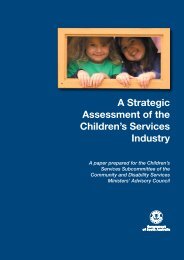Global Study On Child Poverty And Disparities (PDF) - Social Policy ...
Global Study On Child Poverty And Disparities (PDF) - Social Policy ...
Global Study On Child Poverty And Disparities (PDF) - Social Policy ...
You also want an ePaper? Increase the reach of your titles
YUMPU automatically turns print PDFs into web optimized ePapers that Google loves.
Aspects of these cross-country differences<br />
are also illustrated in Figures 4.3 and 4.4.<br />
Figure 4.3 shows disparities between all urban<br />
and all rural areas in childhood deprivation of<br />
shelter, sanitation and water, while Figure 4.4<br />
shows disparities across regions (the ratio of<br />
the proportion of the population in each region<br />
experiencing deprivations, between the regions<br />
with the lowest and the highest deprivations). In<br />
both cases, countries are ranked by deprivation<br />
in shelter, sanitation and access to improved<br />
water sources. In terms of water deprivation,<br />
Vanuatu has the third highest level of disparities<br />
in deprivation of all the countries, while in shelter<br />
deprivation it has the largest disparities between<br />
urban and rural areas.<br />
In terms of regional disparities, Vanuatu is middle<br />
ranked on water deprivation, but in terms of<br />
shelter deprivation, it has by far the highest<br />
regional disparities. In terms of disparities in<br />
sanitation deprivation, Vanuatu performs better<br />
than most of the other countries in the comparison<br />
group.<br />
Figure 4.3: Urban-rural disparities in severe<br />
deprivation, Vanuatu and selected Asian countries<br />
18<br />
16<br />
14<br />
12<br />
10<br />
8<br />
6<br />
4<br />
2<br />
0<br />
Shelter Sanitation Water<br />
Cambodia Philippines Mongolia Lao PDR Vanuatu Vietnam Thailand<br />
Source: Minujin, A., 2010,<br />
Figure 4.4: Regional disparities in severe<br />
deprivation, Vanuatu and selected Asian countries<br />
Shelter Sanitation Water<br />
90<br />
80<br />
70<br />
60<br />
50<br />
40<br />
30<br />
20<br />
10<br />
0<br />
Lao PDR Cambodia Mongolia Vanuatu Thailand Vietnam Philippines<br />
Source: Minujin, A., 2010<br />
Final comments and recommendations<br />
This study has explored disparities in child well-being<br />
in Vanuatu using a range of measures of expenditure<br />
poverty as well as indicators of deprivation. As is already<br />
well established in other regions of the world, this<br />
methodology has considerable strengths. The use of a<br />
multidimensional approach shows that some aspects<br />
of child poverty in Vanuatu are corroborated whichever<br />
approach is used, while others are only revealed by one<br />
or another approach.<br />
As noted by UNICEF EAPRO (Minujin A., 2010, p. 60),<br />
the multidimensional and child-focused approach to<br />
child poverty used in this and other studies provides<br />
important and broad evidence about child well-being<br />
based upon extensive disaggregated data analysis. The<br />
approach can be seen to be significantly more valuable<br />
than conventional sectoral situation analysis as it allows<br />
analysis to focus on holistic needs of the children who<br />
require all the elements of nutrition, health, water,<br />
sanitation, education, information and shelter to thrive<br />
and achieve their full potential. This approach is a good<br />
fit for policy makers who need to consider the delicate<br />
balance between various sectors who have competing<br />
demands over limited resources. The multipledeprivation<br />
and monetary approaches to child poverty<br />
are also complementary ways of gathering information<br />
about the situation of children and their families. Each<br />
method captures information about different groups of<br />
children for whom interventions need to be different.<br />
From a research and advocacy perspective, a number<br />
of conclusions and recommendations can be advanced.<br />
Promoting child well-being in Vanuatu requires continued<br />
commitment to evidence-based policy. Future collection<br />
of household expenditure survey data and further MICS<br />
surveys, followed by detailed analysis of the position<br />
of children, is a prerequisite to improved policies to<br />
promote child well-being. The availability of statistical<br />
data and the development of monitoring and evaluation<br />
systems are critical parts of trend analyses that are<br />
necessary to assess social progress in Vanuatu.<br />
In terms of substantive policy conclusions, disparities in<br />
child well-being in Vanuatu are marked in two particular<br />
regards. First, both deprivations and poverty have a<br />
very strong regional dimension. The remote provinces<br />
of Torba and Tafea face some of the most significant<br />
disadvantages in Vanuatu, and these challenges appear<br />
to be due to their distance from the capital and to the<br />
greater role of informal labour and home production in<br />
these areas.<br />
At the same time, certain problems are worst in Port<br />
Vila. Notably, due to the higher cost of living in the<br />
capital and the greater reliance on cash incomes and the<br />
formal labour market, expenditure poverty as measured<br />
by the regional BNPL is the highest. In addition, Port Vila<br />
74
















